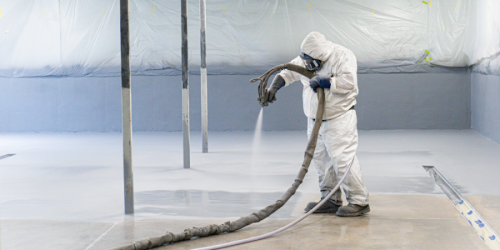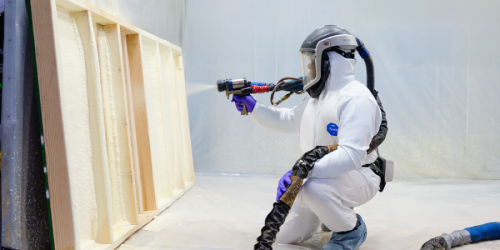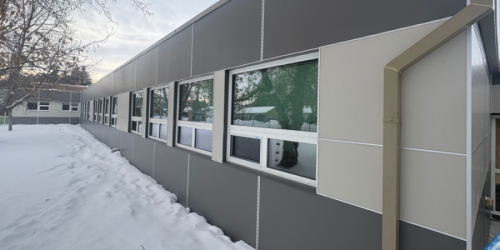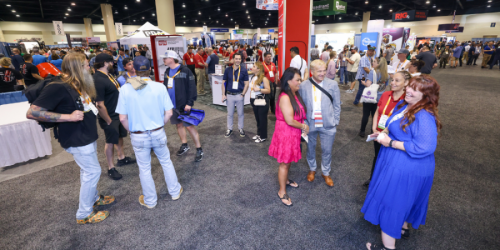Q&A Forums
SPRAYING A VENTED ATTIC Post New Topic | Post Reply
| Author | Comments |
|---|---|
|
Gianni Latona
Posted: Jan 12, 2011 07:16 PM
|
SPRAYING A VENTED ATTIC
Obviously every attic is different when it comes to ventilation, right now I am working on a mega house with vented soffits around the perimeter. What have you guys done to prevent spray foam from coming out of soffits etec. I have tried using a piece of plywood to spray over but when you pull it, the foam comes along.I know some people might say put fiberglass and spray over, any thoughts?THANKS TO EVERYONE! |
|
SprayFoamSupply.com
Posted: Jan 12, 2011 08:33 PM
|
Why would you pull the plywood off? Just spray against it and leave it in place. Or use foil faced polyiso board. |
|
Gianni Latona
Posted: Jan 12, 2011 09:06 PM
|
Vented attic/soffits mean that there should be an air stream from the soffit through the baffle to the ridge line. If i wanted to do a similar easy method as you stated, i would just stuff it with fiberglass and spray over but in this application cant be done. We have baffles going from roofline to soffit for air circulation. |
|
Ivan Pauliuchenka
Posted: Jan 12, 2011 09:12 PM
|
Spray a `little ban`(like a test bun) somewhere (like on the plywood to underside of the roof or else) and then in few seconds (before complete curing) take it of the surface and `stuff it in the hole`. Works good when get use to it. |
|
mason
Posted: Jan 13, 2011 08:12 AM
|
Many folks use polyiso board because it is easy to cut and spray up to it. The foam will seal off any cracks and gaps. You can use almost any material that stays in place including fiberboard. Then the soffits stay open and vented but the attic space is unvented. |
|
Posted: Jan 13, 2011 09:16 AM
|
vent chute stapled in place to roof deck.. r11U filterglass batt stapled far back on top plate as possible across the bottom,,, and a couple three or four on each side along the rafter truss/roof deck laterally should hold it in place just fine... you have r value (crappy as it is,,jim) for a block out,,fast easy install,,and did i say cheap and easy to haul,,,and then you hammer it in with let say 3" cc or 4-5" oc from the top plate to the roof deck,,stopping the active windwash over the attic,,,whatever insulation they put in there...or,,, if your real busy,, you pay one of your local filterglass buddies to do it for you,,,,walk in the door and hammer foam,,,get in,,get out,,,get your check,, now we have done some friction fit as well,,,kinda double the space,,if its a 4" gap,,cut a 8" piece of filterglass and kinda roll it in so the ends go to the outside,,,it leaves the center roll to the interior,,and is easy to build on...(i reread that,,it makes no sense,,nevermind..lol).. but how ever you block it,,,demand it be blocked at the exterior of the wall,, ever notice how the filterglass folks take a kraft batt and staple it to the front (warm side) of the wall,??think about the cold air comin in on the back side,,,over the top of the wall system,,convective looping jim???no doubt.. |
|
quentin
Posted: Jan 13, 2011 10:53 AM
|
We just cut a bunch of polyboard you get cheap at lowes or etc to fit, jam them in place and spray. Works well for us and if you cut it BEFORE going up it moves fast. On ridge vents we just do a fast shot to build a block with the foam where it won't go up the vent or maybe some of the heavy paper you lay down on floors. I am thinking of using the fi-foil on one to see how well it holds up since it is cheap, easy to cut and would reflect heat back up the ridge vent better. Heck, you can just cut and set that in the sofit since you really are only looking for a solid surface to spray against. |
|
SPFer
Posted: Jan 13, 2011 02:40 PM
|
Here's a link to a good product. Not the cheapest, but very easy. |
|
jimcoler
I have over 10 years of experience specifying and installing open and closed cell spray foam. I've sold my business but I'm still selling for the new owners and consulting on large and custom specific jobs. I've expanded my knowledge into t Posted: Jan 13, 2011 04:21 PM
|
Ok, we use Low-E reflective insulation (much like Fi-Foil) but better becasue it's made from recycled milk jugs and is a closed cell foam inside the foilfacing. We cut it to the rafter width and then staple it up to the underside of the roof with a couple of loop-d-doos which allows the air to flow form the soffit to the ridge. So, if you're looking at a cross section of this, you could say that it's in the shape of a "W" with the top vent chutes fro the soffit to the ridge! It's flexible, easy to work with, easy to cut and as Quentin says, it does reflect the heat from the solar heat gains in the summer time up and out to the vent channels. This is an optimal way to build! We're doing this on a bunch of homes along with the Low-E in the crawlspace! It's great for crawlspace floors because you get a vapor barrier, radon retarder, and thermal break all in one for a greta price! And the nice part is you only have to carry a roll of it in your truck which covers 500 sqft! Mention my name or that you heard about this on this site if you call them or contact Low-E Northeast to maybe get a discount! Thanks, Jim |
|
Gianni Latona
Posted: Jan 13, 2011 04:45 PM
|
Thanks for all your help guys, really appreciate it!!!! P.S. Any one ever experience your face being really red after a day of spraying. I use side cartridges and a pretty vented area. Obviously could be just from having a mask on all day. Being observant of chemical hazards is one of all our biggest concerns!! |
|
mason
Posted: Jan 14, 2011 09:37 AM
|
In a confined space such as an attic or interior room, you should use air supplied respirators. There may not be quite enough breathable air in the attic particularly if you are spraying a lot of foam. Plus, the fumes and mists created are going to be well over 10 times the PEL (permissable exposure level) for MDI in those circumstances. An air purifying respirator is only good up to 10 times the PEL. You might also, just be hot. I get overheated very easily nowadays and my face gets very red when I spray using an air purifying respirator. Be sure you drink plenty of fluids and take sufficient breaks to prevent overheating. |
|
jimcoler
I have over 10 years of experience specifying and installing open and closed cell spray foam. I've sold my business but I'm still selling for the new owners and consulting on large and custom specific jobs. I've expanded my knowledge into t Posted: Jan 14, 2011 07:48 PM
|
So, this may be the subject of a new tread, but what testing data does the EPA, NIOSH, and OSHA have that can support their claim that only an air supplied respirator should be used? What about with pre filters and high level filters including Organic Vapors/Acid Gases Respirator Cartridges or the Multi-Gases/Vapors/P100 Respirator Cartridges, Multi-Gases/Vapors Respirator Cartridges, Formaldehyde, Organic Vapors Respirator Cartridges,Organic Vapors, Acid Gases, HEPA Respirator Cartridges, Ammonia, Methylamine Respirator Cartridges, Mercury Vapors, Chlorine Respirator Cartridges, ....? The last I heard, they only did about 7 tests and all of their data was compormised by mixing of the sprayer and trimmer and no ventilation. So, how much ventilation is enough? These were the questions I asked them at the SPFA conference last year and they couldn't answer them. They only had subjective information to based their guidelines on. So what testing was done and with what filter systems, and what respirators and what ventilation?? I think each of these can have a significant impact on the amount of gases ingested/inhaled and the respirators do work! Otherwise, I would never of had a guy who has asthma doing the trimming and spraying! Also, the last I heard it was stil a guideline and there was no law stating that you had to use outside air respirators. Again, is OSHA is the law then I;d like to see where it is stated as such! Jim |
|
Gianni Latona
Posted: Jan 15, 2011 08:45 AM
|
I think the spf chemcial companies should conduct more independent testing and methods for us contractors. They basically put nice warnings on their barrels or msds sheets just to cover their rear end. In a world of law suits, we all need to be educated on this. I use organic vapor cartridges and am pretty happy with them, never had any problems. Also in terms of ventilation, we all need to be careful of our out going ventilation because fumes do escape the work zone and we can also affect people not on the jobsite. |
|
quentin
Posted: Jan 15, 2011 05:45 PM
|
Anymore I am wondering if it is the fiberjunk companies running the show since we are seeing more and more regulations that increase our costs. Heck, you are supposed to wear a resperator when putting up fiberjunk but when was the last time you saw that? They do not have to follow the rules I have been seeing but they are all over us on them. Of course the SPFA just ignores the contractors except to beg for money from us before running us over with their own bus. As for the resperators, I use either depending. In a small confined space where I know the fumes will be concentrated like a crawlspace, then I use a supplied air source. Spraying a room in a house or etc, then the organic resperators are usually used instead. I just wish they would make a mask setup that does both AND has a camelback water supply you can drink from while spraying. |
|
SprayFoamSupply.com
Posted: Jan 16, 2011 08:53 AM
|
3m 6000 series masks can be used with filters or with supplied air. |
|
mason
Posted: Jan 16, 2011 09:29 AM
|
The Center for the Polyurethanes Industry and SPFA conducted testing of sprayfoam to interior applications a few years ago. Jacques Lesage was the person chosen to conduct the tests. The tests themselves were determined by the Product Stewardship committtee of CPI with heavy input from SPFA> It was based on more than 30 years of monitoring data on sprayfoam applicatons to find the test procedures and apparatus that could be most consistent in determining airborne concentrations of MDI The monitoring was done in Canada and in the US in what was considered typical residential construction. (windows and doors installed but no drywall) There were area monitors and personal monitors. The smaller rooms had more than 10 times the PEL and the other rooms very close to it. You can obtain this data and research from either CPI or SPFA. This is also the data that was used to develop the Respirator Protection Program that is available online from CPI> I agree if there is plenty of ventilation that you may be able to use an air purifying respirator but you would have to do the monitoring to demonstrate it to OSHA. I am aware of one contractor who performed this testing some 25 years ago in South Texas. The demonstrated that they could wear air purifying respirators when insulating large cold storage facilities Size of the warehouse they insulated was over 200 foot long and 25 ft high. So, if you want to use air purifying respirators indoors, you can do the testing on your most critical applications. If it tests out less than 10 times the PEL you should be able to use it on other applications without ventilation I think this type of testing runs around $15,000. |
|
Posted: Jan 16, 2011 05:37 PM
|
|
|
jimcoler
I have over 10 years of experience specifying and installing open and closed cell spray foam. I've sold my business but I'm still selling for the new owners and consulting on large and custom specific jobs. I've expanded my knowledge into t Posted: Jan 16, 2011 09:53 PM
|
So Mason, How many tests were conducted and how valid was the data - meaning is the data real and true for a sprayer and trimmer or mixed employees? Also, is it real regarding the ventilation which does exist and can exist? Did they use a fan? Was it blowing in or out or both in and out of the building/room? It's my understanding that they did testing which was under 20-30 tests with compromised data integrity - meaning that the sprayer was sometimes the trimmer and the trimmer sometimes the sprayer. In addition to this, there was no excess ventilation in the areas measured? They admitted that at the SPFA conference in front of all attendees last year! As far as CPI and the SPFA, I'm appauld at their lack of spine in responding to this situation and just rolling over! Neither CPI nor SPFA represented us in this matter as described above! They just agree to the demands of OSHA, NIOSH and the EPA! Are you saying there data is based on 25 year old testing? How do you or anyone else expect us to be able to afford the $15,000 for the monitoring testing equipment and who would believe us anyways? We can say that the PEL is under 10 times, but who has the final say? WHo can afford this? Not me this year! I'd rather spend it on 3 IR cameras for $5K each! SO, what your saying is if I cna prove otherwise, I can do otherwise, but unless I cna prove it, I have to obey their guidelines? Right? They are still guidelines, right? That means that we don't have to obey them because they aren't law?? Right? I'd like to see a link to the data and not just general data either! I'd like to know how many different sites were monitored, using what equipment, when it was calibrated, how much ventilation (intake or exhaust), how far away were the monitoring systems placed, where were they worn? These are all valid questions among others that I'm sure come up with the testing details! And they all lead to the testing validity! Besides all of this, so how come the fiberglass isn't scrutinized near as much as we are and may be/Maybe not using a dust mask to install it and it's a known carcinogen and the fibers wil also aggitate asthma! Thanks, Jim |
|
jimcoler
I have over 10 years of experience specifying and installing open and closed cell spray foam. I've sold my business but I'm still selling for the new owners and consulting on large and custom specific jobs. I've expanded my knowledge into t Posted: Jan 16, 2011 10:25 PM
|
FoamDude... Did you intend to chime in on this?? I hope so for the SPFA? Thanks, Jim |
|
Posted: Jan 17, 2011 07:29 AM
|
ok jim lets word this so you understand,,, when i chime in it is what i say,,, i could give a shizzle what the spfa says,, and dont speak for them,, go spray some foam jim,,your moderately abrasive,, and your agenda,,well ,,,like i said before.. good luck big boy yes i intended to post,,then i checked my words,,,something you should consider cause once you launch it,, example: spraying to fififumfoil or similiar=BRILLAINT not edit #2 and while im friggin bealin.. jim,,i am a friggin contractor...nothin else,, i work every day,,7 a week,,the spfa wanted contractor input and obtained votes from their membership,,i got voted in for this position...this did not make me an employee of the spfa,,nor do i have,,,nor am i expected to have my nose up their bootyismaximuss,,,i forwarded the comments from my post previous,,,got beat up pretty good for it too,,,but screew them,,,i dont want them to luv me either so continue on,,,razzle em |
|
SPFer
Posted: Jan 17, 2011 01:20 PM
|
Good banter! George, you mentioned the 3M 6000 series are compatible with both cartridges and supplied air. We use those masks, but I was not aware we can use them with supplied air. Is there an adaptor to hook them up to supplied air? Is it a simple changeover? Thanks |
|
steven argus
Posted: Jan 17, 2011 03:28 PM
|
Ah yes, I too am a fan of the banter. Caddis, not to get off topic here, 2 of my guys wear the 6000 series w/ supplied air adapters. (supplied by George) One wears them w/ the supplied hoses and caps. One guy prefers to put the filters on over the hoses. (where the caps are supposed to go) That way, when some one is standing on his air line, its not choking off his air. And yes, it's a very simple change over. Takes 2 seconds. |
|
mason
Posted: Jan 17, 2011 03:46 PM
|
You should be able to obtain the complete air testing report from SPFA or CPI. We distributed the complete report to SPFA members after it was completed and had a session at the sprayfoam conference dedicated to it at the time. The tests did include both area and personal monitors. 20 ft, 10 ft, 5 ft away from the area. The type of test was determined by reviewing air monitoring that was conducted before. one of the problems of the test procedures is that the mists in the air tend to clog up the equipment so that inaccurate reading are possible unless the right equipment and procedures are used. So the task group tried to find the test procedures and equipment that would not get clogged with sticky foam particles in the air. OSHA will require you to provide information that you used to determine what type of respirators that you are using. Past experience has demonstrated that it is up to the contractor to provide that information. CPI and SPFA did the testing so that the contractor did not have to perform testing themselves in a "typical" residential insulation project that does not have engineering controls such as added ventilation. Because the variables can be considerable, the testing did not include every variable that is possible. The recommendations were vetted by a lawfirm that specializes in air quality issues and OSHA regulations based on their experiences with thousands of air monitoring cases within the polyurethane industry. You can always ask the industry to conduct additional testing for a specific type of ventilation that would be representative of a large number of residential insulation applications. Get a dozen applicators to pony up $1000 each and you can get the testing done. I have copies of the presentation at the sprayfoam conference and may have the original test program report. (not sure, i am on the road and have to check my hard files at home). Email me Jim for the copies. |





























